June 6th, 2011 § § permalink
Seems odd, but at one time New York had more German restaurants than Italian restaurants. In terms of time, the ubiquitous pizza joint is a fairly recent trend. Yorkville, the traditional German neighborhood in the East 70s and 80s (bordered by Lexington Avenue), had lots of German dining spots that fit all budgets. Despite World War Two and the Nazi-loving German American Bund (headquartered in Yorkville and run by the thuggish Fritz Kuhn), New York’s many German eateries flourished well into the 60’s. Luchow’s, of course, was one of the city’s greatest restaurants and did honor to the best traditions of German cuisine, wine and beer.
A particular HG favorite was the Blue Ribbon in the West 40’s, much favored by journalists. HG often lunched on steak tartare (better than any served in Paris then and now), kassler ripchen (smoked pork chops) and grilled bratwurst. The home fries were incomparable. After a boxing match, basketball game or hockey tussle at the old Madison Square Garden (then located at 50th and 8th Avenue), HG and buddies would gorge on the Blue Ribbon’s huge apple pancake (bigger than the biggest pizza) washed down with dark German beer.
The demise of German restaurants in New York, HG opines, had more to do with changed eating habits than politics. Cholesterol fear trumped anti-Nazi sentiments. What remains of German food glory is the great German pork, sausage and cured meat emporium, Schaller and Weber, located on Second Avenue and 85th Street. If you can’t get there order online and enjoy some of the best wintry treats. Oompah.
June 4th, 2011 § § permalink
With the delicious irony that only Middle Europeans are capable of, waiters at the long departed Eclair Bakery/Restaurant on New York’s West 72nd Street, referred to each other as “Herr Doktor.” Eclair’s heyday was the late 30’s through to the 60s. Its customers were the Europeans, primarily Jewish, who had fled Hitler and wound up, for the most part, in the Washington Heights and Upper West Side neighborhoods of New York. Yes, many of the waiters had been Doctors in Europe, or lawyers, or architects, etc.. In New York they were waiters. They did not bewail their fate. They were alive.
Eclair catered to displaced novelists, musicians, singers, actors, artists and a host of intellectuals of every cerebral and artistic variety. And, the little, bald guy in the corner was Isaac Bashevis Singer (long before he became famous), eating his inevitable (he was a vegetarian) tuna fish sandwich. The women in the Eclair were bosomy, voluble, perfumed and flirtatious. It was a sexy place, echoing Viennese, Budapest and Bucharest coffee houses. The pastries were outstanding. Coffee came adorned with three inches of schlag (whipped cream). It was more than a bakery. Eclair was also a restaurant with outstanding wiener schnitzel, chicken paprikash and other artery clogging specialties of Mittel Europa. A multitude of languages was spoken at Eclair—German, Russian, Polish, Hungarian, Czech, Yiddish, Rumanian. To HG’s young ears it was all music. Eclair was owned by A.M. Selinger, Italian-born, Czech-reared. When he died in 1998 his New York Times obituary summed him up perfectly: “However long they lingered, the Eclair customers found a ready welcome from the proprietor, a small, natty man of legendary conviviality. a wide circle of friends and a vast array of pluperfect pastries.”
Whenever HG thinks of him, HG smiles
May 8th, 2011 § § permalink
HG has posted before about the wonders of the Russian Tea Room when it was run by the late, great Sidney Kaye. HG had a charge account at RTR and since his offices were directly across the street from the restaurant, HG lunched there at least three times a week. There was also an occasional blini-red caviar-melted butter-sour cream weekend brunch. A few sumptuous dinners here and there, not to mention a good number of after work vodkas at the bar. In time HG’s tab began to resemble the national debt. Then, for some reason, monthly statements stopped coming. Guilty HG phoned Sidney. Here’s Sidney’s response: “Goddamn bookkeeper. Can’t anybody do anything right? I should fire everyone and start all over again. You owe me money? So what? You’re the least of my worries. Goodbye,” Hangs up.
HG kept eating and charging. 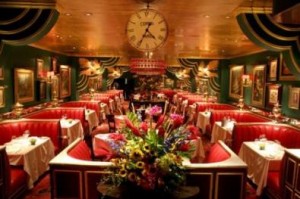
May 7th, 2011 § § permalink
In addition to the Plaza Hotel’s Oak Room, HG , during the slim wallet early years of his marriage to BSK, had charge accounts at Fornos, the Spanish Restaurant on W. 52nd Street and the original Russian Tea Room on W. 57th. Fornos (long gone) was owned by survivors of the Spanish Civil War and was the most joyous eatery in town. HG and BSK were always greeted warmly and were served the best margaritas imaginable. BSK stopped at one. HG, alas, continued to drink them throughout the meal.
The food: Roast pork with addictive Spanish potatoes that were fried in duck fat and onions then dusted with smoked pimento; perfect gazpacho; seafood or chicken and chorizo paella; shrimp in a rich garlic sauce of fish stock and parsley; Mariscada (seafood stew); garlic rubbed sirloin steak with more of those addictive potatoes. Dessert (for HG) was one or two or possibly three banana daiquiris; For BSK, light as ether Flan — HG always needed a bit of assistance upon leaving Fornos. BSK did not.
At one point, HG’s charge grew to such proportions that HG ceased going to the restaurant out of shame. Call from the proprietor. HG thought there would be stern words. Instead, this is what he heard: “Where have you been? We miss you. You owe us money? Nada. Not important. We know you are an honorable man. You will pay us when you are able. Meanwhile, come in and let us have joy together.” HG paid up, of course, and continued to get sozzled at that merry and generous establishment.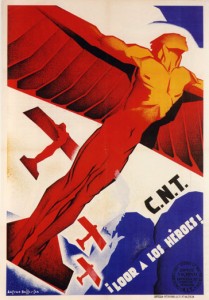
May 4th, 2011 § § permalink
In the early years of their marriage, HG and BSK often suffered from the money shorts. This did not prevent the Young Marrieds (and recent parents) from living very well. Indeed, when wallets were empty, HG and BSK went to the sumptuous Oak Room of the Plaza Hotel where HG had a charge account. The Oak Room radiated chic and old fashioned glamour. HG and BSK once dined at a table next to one occupied by Cary Grant and a merry party. It was a fitting setting for that most debonair of movie stars.
And what was on the menu for impecunious but happy HG and BSK? Beverages: Icy vodka martinis (for HG), carafes of the very good house Chablis and house burgundy (for BSK and HG) . First course: Thinly sliced Scottish smoked salmon with capers, lemon and olive oil. Buttered brown bread. Main: Tournedos (rare chunks of the center of beef tenderloin) in a fragrant wine sauce. Sides: Souffle potatoes wrapped in a linen napkin and served in a silver dish. Braised celery topped with beef marrow. Dessert: Chocolate pots de creme. Truly luxe dining. And, the Plaza never murmured when it took HG six months to pay the bill.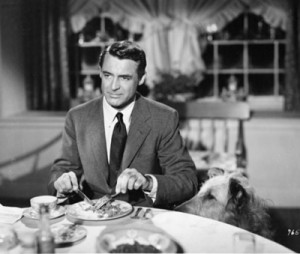
April 30th, 2011 § § permalink
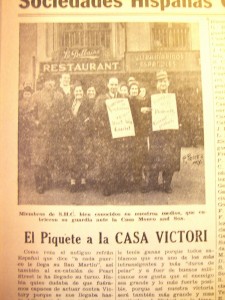 During HG’s college days (not a century ago…but close), HG had to choose between two venues for HG’s romantic Saturday night dinner-and-movie dates.
During HG’s college days (not a century ago…but close), HG had to choose between two venues for HG’s romantic Saturday night dinner-and-movie dates.
There was the inevitable Chinese restaurant which charged 50 to 75 cents for a choice of egg drop or wonton soup; a “combo” platter and a desert of an almond cookie with tea. And, there was the more ambitious, but still very affordable, Spanish restaurant, La Bilbaina, on West 14th Street which was at the heart of the now extinct “Little Spain” neighborhood. La Bilbaina had bullfighting posters, exciting flamenco music on its sound track and candles on its tables. A scene to stir tender emotions. Dinner consisted of a large bowl of spicy bean and kale soup followed by an oversize platter of yellow rice, lots of red beans and hot chorizo. In fact, much of the La Bilbania menu consisted of beans in various forms and lots of garlic. The beverage was a rough and ready sangria. To call the wine plonk would be dignifying it, but it quenched the thirst. Dessert was flan. Total cost of dinner a deux (with tip) hovered around $3.50.
One may question whether a meal chock full of beans was the proper prelude to romance. Gallant HG and his earthy girl friends found a bit of musical accompaniment no impediment to young amour.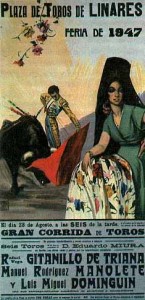
April 17th, 2011 § § permalink
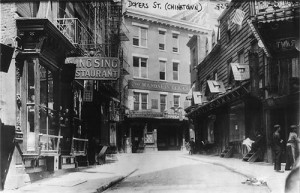 In 1957, a super-cool pal of HG took him to lunch at Nom Wah Tea Parlor on Doyers Street in New York’s Chinatown. In the days of the Tong Wars when Chinese gangs fought for control of opium, gambling and extortion rackets, Doyers (which is shaped like an elbow) was called “The Bloody Angle” and it was a veritable killing field. But, all was peaceful when HG dug into a meal of steamed and fried dumplings, pork buns, spare ribs and other savories. HG learned this type was food was known by the collective name: Dim Sum. The Dim Sum was brought to the table on carts wheeled by serious Chinese women. The danger was stuffing oneself on the offerings of one cart when an even better cart was waiting in the wings. Condiments were hot mustard and Hoisin sauce. The beverage was tea, of course, but HG supplemented this with a bottle of cognac. That first visit led to scores more. BSK became a devotee as did gifted daughter LR and SJ. Nom Wah was ludicrously cheap, of course, as was everything in the Chinatown of that era. HG had many feasts of fried crabs in eggs sauce ($1.75 at Wing Fat) , shrimp in black bean sauce ($1.25 at Yuet Sun) and other laughably priced delicacies up and down Mott Street. How about surprisingly good grilled pork liver for 45 cents? In oncoming years Chinatown was flooded with huge, Hong Kong-style dim sum parlors. HG hasn’t been to Nom Wah in years and didn’t know if it even existed anymore. Voila! Nice story in NY Times a few days ago. Still in business under management of new generation of owners. No carts. Dim sum made to order. Still good. Still cheap. Decor has been kept the same with only some very minor refurbishments. Can’t wait to get back and refresh happy memories.
In 1957, a super-cool pal of HG took him to lunch at Nom Wah Tea Parlor on Doyers Street in New York’s Chinatown. In the days of the Tong Wars when Chinese gangs fought for control of opium, gambling and extortion rackets, Doyers (which is shaped like an elbow) was called “The Bloody Angle” and it was a veritable killing field. But, all was peaceful when HG dug into a meal of steamed and fried dumplings, pork buns, spare ribs and other savories. HG learned this type was food was known by the collective name: Dim Sum. The Dim Sum was brought to the table on carts wheeled by serious Chinese women. The danger was stuffing oneself on the offerings of one cart when an even better cart was waiting in the wings. Condiments were hot mustard and Hoisin sauce. The beverage was tea, of course, but HG supplemented this with a bottle of cognac. That first visit led to scores more. BSK became a devotee as did gifted daughter LR and SJ. Nom Wah was ludicrously cheap, of course, as was everything in the Chinatown of that era. HG had many feasts of fried crabs in eggs sauce ($1.75 at Wing Fat) , shrimp in black bean sauce ($1.25 at Yuet Sun) and other laughably priced delicacies up and down Mott Street. How about surprisingly good grilled pork liver for 45 cents? In oncoming years Chinatown was flooded with huge, Hong Kong-style dim sum parlors. HG hasn’t been to Nom Wah in years and didn’t know if it even existed anymore. Voila! Nice story in NY Times a few days ago. Still in business under management of new generation of owners. No carts. Dim sum made to order. Still good. Still cheap. Decor has been kept the same with only some very minor refurbishments. Can’t wait to get back and refresh happy memories.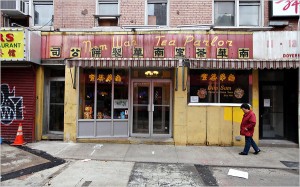
March 14th, 2011 § § permalink
While watching “Boardwalk Empire“, the HBO series about Atlantic City’s prohibition days, HG’s thoughts turned to Longchamps, that long gone, magical chain of New York restaurants.
Where’s the connection ? Well. One of the principal bad guys in “Boardwalk Empire” is New York crime kingpin (and World Series Fixer!) Arnold Rothstein. A.R. had a brother-in-law named Henry Lustig who was in the food business. A.R. owned an attractive piece of real estate at 78th and Madison. A.R. put up the money and real estate and a restaurant chain, Longchamps, was born. Longchamps was, of course, named after the Paris race track. The name was apt: A.R. and Lustig were gamblers (A.R. was shot and killed while playing cards). Both men loved horses and they wanted the restaurant chain to evoke a Parisian flair (though the cuisine was American and international). Eventually there were 12 Longchamps restaurants in New York. They were pure theater. The colors were red, gold, yellow and black. The interior design was by the German art deco expert Winold Reiss (with an assist from New York architect Ely Jacques Kahn). Multi level, beautifully lit, Longchamps had suave service and excellent wine lists. In the beginning, it copied the European custom of forbidding tipping by simply adding a 10% charge to the bill. The food was marvelous. And, the price was right. Not cheap. Not super expensive. Just in the middle. Everything went well until 1946 when the IRS slapped Lustig with a $10 million tax bill and a fraud indictment (he spent four years in prison). Longchamps was soon in disarray and losing money. Jan Mitchell, the remarkable restaurateur who had revived Lüchow’s, the great German restaurant on 14th Street, bought Longchamps in 1959 and quickly restored it to glory. From 1959 to 1967 (when Mitchell sold out and the chain disappeared), HG was a frequent customer. Pot a Feu (better than Paris); lush spaghetti with chicken livers; creamy chicken curry; lamb chops; eggs benedict and the ultimate roast beef hash. Breakfast. Lunch. Dinner. Longchamps always hit the spot. Following their wedding in judge’s chambers on Foley Square, HG, BSK and the wedding party celebrated with eggs benedict and champagne at the Longchamps opposite City Hall. In memory, every meal at Longchamps was a celebration.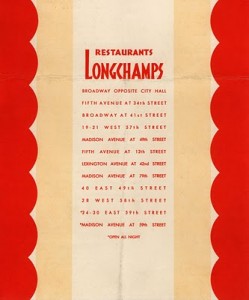
March 13th, 2011 § § permalink
During its heyday (1930’s-1970’s), the Horn and Hardart Automat chain of restaurants fed some 350,000 to 500,000 New Yorkers and Philadelphians daily. Fed them in sparkling surroundings at a very low price. The customer put nickels in a slot and out popped the world’s best macaroni and cheese casseroles, baked bean casseroles, chicken pot pies, beef pot pies. There were exemplary salads, pies, cakes, sandwiches (the BLT was a winner). The diner could also take his tray to the cafeteria section for beef stew, Salisbury steak, roast chicken and an array of vegetables (Harvard beets and mashed potaoes were HG favorites). Say the word “Automat” to a New Yorker of a certain age and get a big smile. Automats were fun. Gregory Peck, Tony Curtis, Woody Allen, Leonard Nimoy, Jerome Robbins, Neil Simon and Dick Clark all loved the Automat. So did HG. Armed with a handful of nickels little HG felt like a true adult as he assembled his meal of macaroni and cheese, coconut custard pie and hot chocolate. The last Automat (southeast corner of 42nd and Third) closed in April 1991, just about 20 years ago. For those who want to reignite memories, the Smithsonian in Washington has a 35 foot section of the Automat on display. But, unfortunately, no piping hot macaroni and cheese.










